There has been a lot of debate on what type of content to create after Google’s August 2022 helpful content update. A subsequent update was rolled out by Google in March 2024 that targeted low-quality and spammy content. The purpose of this update was to reduce unhelpful content by up to 40%.
The only way to keep driving organic traffic in years to come is by creating and publishing helpful content that both readers and search engines love.
Let’s dive in and see what helpful content is, what are its characteristics, and how you can produce it and avoid losing search ranking and traffic.
What is Helpful Content?
Google defines helpful content as high-quality content written by experts for a specific target audience. It covers the topic completely and aims at satisfying the reader.
Back in 2022, Google updated its algorithm to reward websites that publish quality content that targeted people instead of search engines. This update has become a core part of the ranking algorithm. After the update, sites that were writing content specifically for search ranking were targeted. Google terms this type of content as search engine-first content.
Content that’s created for search engines isn’t helpful as it fails to satisfy searcher query completely. Consequently, search engine-first content is discouraged while people-first content that’s more helpful is encouraged and rewarded by Google.
Helpful Content Principles
Before you go ahead and start creating helpful content, it’s essential to understand the basics of helpful content and its key characteristics. Here’s a list of the major principles of helpful content as shared by Google:
1. Target Specific Audience
Content targeted towards a specific audience works best. You need to identify the primary target audience for your site and every piece of content you generate.
The primary question Google wants you to answer is: Do you have an existing or intended audience for your business or site that would find the content useful if they came directly to you?
This calls for understanding your target readers and figuring out what type of content they are interested in. There are multiple ways to do it:
- Do keyword research
- Target search intent
- Use Google Analytics to find your best-performing content and other details such as demographics to better understand your existing audience
- Create and use buyer personas
- Have a clearly defined purpose and objective for your website and blog.
2. Showcase Expertise

The content needs to showcase the expertise of the writer. If you aren’t an expert in a topic, you shouldn’t write about it. Period.
Google uses a wide range of signals to figure out if the person writing a piece of content is an expert on the topic. These include:
- Author bio and links to author’s social media accounts such as LinkedIn
- Reader satisfaction which is measured by dwell time, bounce rate, and repeat queries
- How accurate the content is. This is determined by outgoing links and consensus
- Proof of license, academic qualification, associations, and certifications.
For example, a human resource management blog should have a detailed bio of the author including qualifications and what makes them qualified to write content on human resource management. Similarly, a therapist should have his license number mentioned on the website.
Expertise is part of Google’s E-E-A-T terminology used by human quality raters to evaluate search engine ranking quality and relevance. E-E-A-T stands for Experience, Expertise, Authoritativeness, and Trustworthiness:
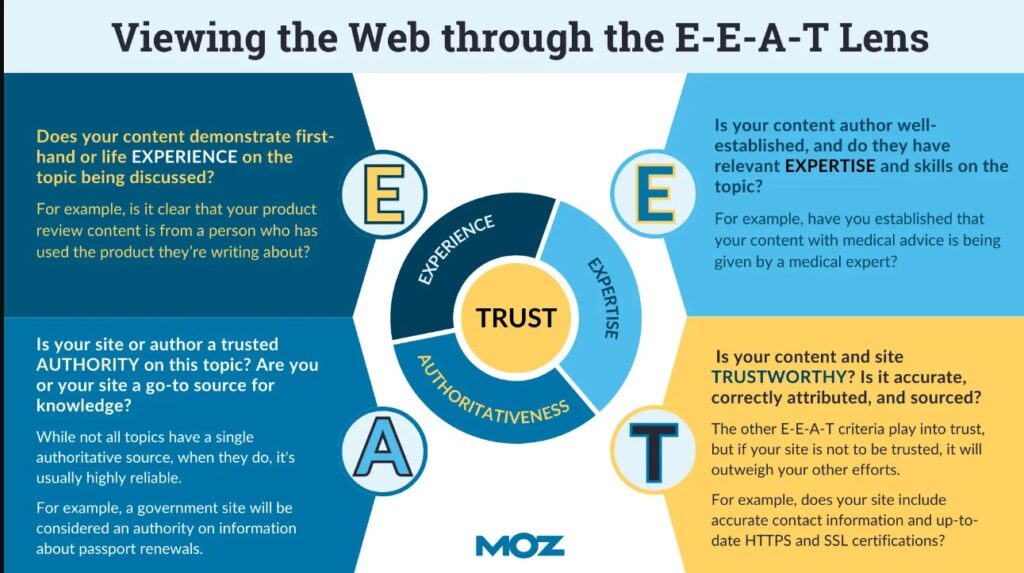
E-E-A-T isn’t a ranking factor but rather a search quality evaluation process. Following it significantly improves ranking and makes your content helpful for human readers.
You have to showcase your expertise by mentioning relevant details on your website, blog, and articles so that search engines and readers can trust you.
3. Exceptional Page Experience
The way how content is presented on your website is an important factor that determines the helpfulness of the content. Well-written content on a poorly designed website will lead to poor UX.
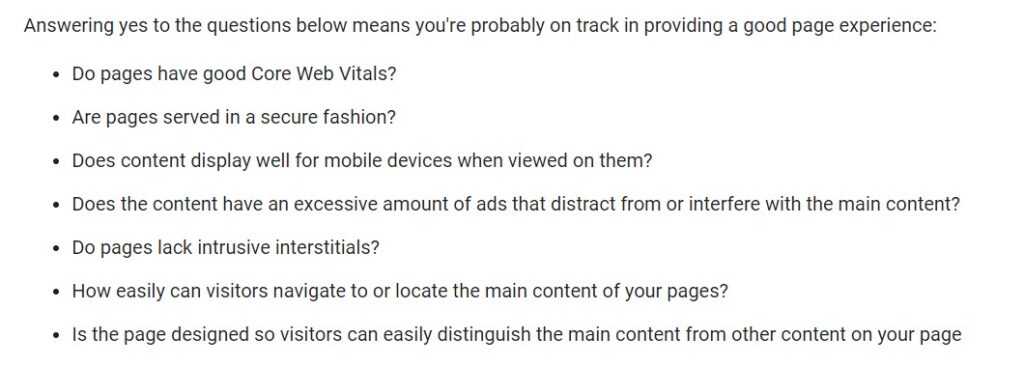
Here’s a list of the major page experience variables that you should look into:
- Core web vitals
- Mobile responsive website design
- HTTPS
- Site structure, architecture, and navigation
- Page design and presence of white space
- Minimal, non-intrusive ads.
User experience makes your content stand out and it boosts the conversion rate by 400%. Visitors value experience more than anything else on your website and this is a reason why Google values it.

Having a great page experience will cover content flaws. But great content can’t cover UX flaws.
4. Searcher Satisfaction
Helpful content satisfies the reader as it is created for people – not search engines.
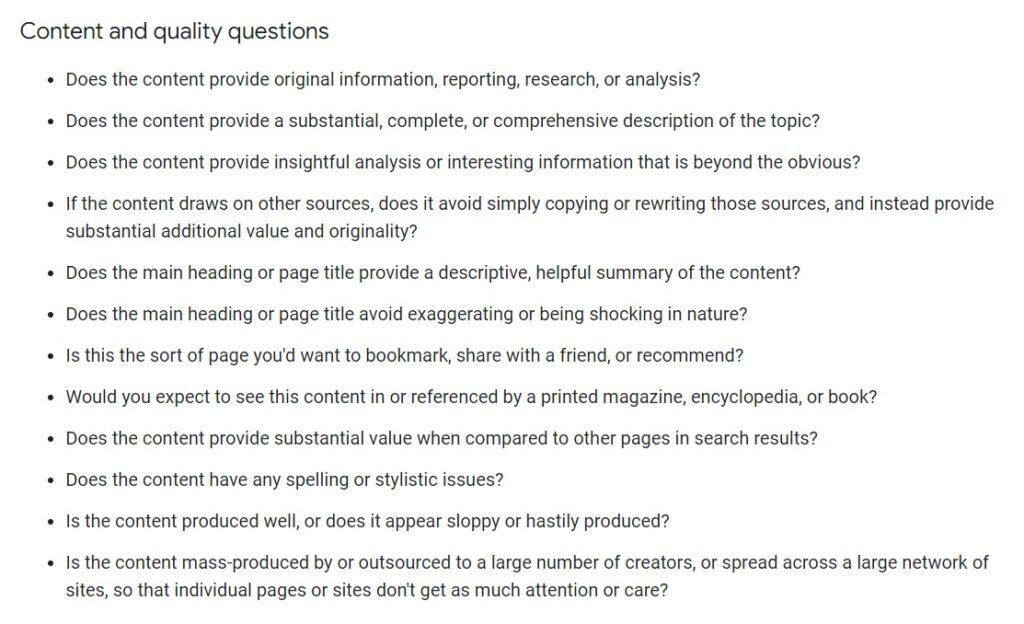
The core reason for creating helpful content is that it should deliver exceptional value to the readers so that they don’t have to run the same search query again. It means content should:
- Cover the topic in detail and touch on all the aspects
- Provide original information about the topic
- Deliver exceptional value more than other pages on a similar topic
- Avoid fluff, claims, hype, and exaggeration.
The basic question you should ask yourself: If this is the type of content that someone would bookmark and visit later?
If your answer is anything other than a loud yes, your content is least likely to satisfy readers and they will continue to find more details on other sources. When a lot of people visit SERPs after visiting your page, Google demotes your content and ranks another page that has a higher satisfaction rate.
How to Create Helpful Content
Here’s a list of the best practices and techniques to write helpful content that search engines and readers love. These techniques are derived from Google’s recommendations and guidelines, so you can trust them without a second thought:
1. Choose Your Audience
You need to clearly define your target audience who’ll read your content. When you have a well-defined target audience, you’ll know what they want to read and this helps you create highly targeted content that’ll satisfy them.
Ideally, you need to create and use buyer personas that simplify the task of identifying the right audience for every piece of content you write.
A buyer persona is a semi-fictional representation of your ideal customers. It is a data-driven and research-based pictorial representation of each sub-group within your target market. Here’s an example of a buyer persona:

You need to create these buyer personas for each target group in your market. For example, if you target both working males and females, you’ll need one persona for working males and one for working females.
Buyer persona development requires you to collect data about your audience such as demographics, interests, challenges, pain points, hobbies, etc. There are multiple ways to collect this info for persona development:
- Use Google Analytics
- Market research including secondary data sources and competitor spying via tools like Semrush and Ahrefs
- Collect primary data in the form of surveys and interviews.
For helpful content, you need to add the following details in the buyer persona:
- Content preferences
- Content format
- Type of content liked
- What problem the persona solves via content
- Preferred channel for content consumption.
You can collect this data through surveys and your analytics tool. Running a short feedback survey on your blog like this would help you collect accurate data:

With detailed and accurate buyer personas, you can create targeted content for each persona instead of creating content that targets everyone in your market.
Google loves content that targets and addresses a specific group of people and solves a problem. This results in high reader satisfaction leading to higher rankings.
2. Make Content Trustworthy
A core attribute of helpful content is that it is considered trustworthy by search engines. Google’s E-E-A-T relies heavily on the trust element:

The trustworthiness of a page is determined by quality raters using experience, expertise, and authoritativeness of your site and content. The content should demonstrate experience, expertise, and authority to be trustworthy.
Your focus should be on the trustworthiness of your content as it covers all the other aspects as they are its subset. Here’s a checklist of how to make your content trustworthy – and eventually helpful for readers:
- Demonstrate first-hand or real-life experience relevant to the content. If you are writing an article on losing belly fat in 30 days, the author should have actually gone through the process and have lost belly fat in 30 days and this should be demonstrated via real photos, videos, and minute details that similar content on the subject lacks
- The author should have relevant expertise on the topic. Medical and health articles should be written or reviewed by an expert in the relevant field
- Develop authority on a given subject or topic. This can be achieved over time when your site has a clearly defined niche and target audience
- All the data and information should be factually correct
- Have enough details about the author, website, and owners with links to their social accounts.
Sleep Advisor is a perfect example of how to demonstrate experience when writing content. They describe their complete review process, share a detailed video, and use tools and devices to report metrics that aren’t available with other mattress review sites:

If you read the article, you know they have purchased and used the mattress they are reviewing.
Healthline, on the other hand, demonstrates experience by telling readers that their articles are medically reviewed by relevant experts. Here’s an example:

Trustworthiness has the highest weightage in the E-E-A-T guidelines and it overweights other factors. Do everything you can to make content and your website a credible source of information for readers and search engines. Follow these best practices to gain reader trust:
- Write epic content that’s extremely detailed (more on this in the next section)
- Tell readers what makes you and/or the writer the best person to write this piece of content
- Add author bio
- Have a detailed about page
- Add internal and external links to relevant sources
- Explain the reason for writing content and clearly explain what problem it is expected to solve
- Add quotes from relevant subject matter experts
- Explain the complete research, writing, and editing process to the readers
- Have clear navigation and hierarchy to improve UX and make it easy for readers to find what they are looking for easily
- Avoid fluff, hype, and incorrect information
- Promote content to gain backlinks that’ll help you improve your site’s authority.
3. Go in Detail
Helpful content is detailed. If you don’t cover the topic comprehensively, you might leave several related questions unanswered which means unsatisfied readers.
Whenever a reader leaves your content and runs the same query or any related query to find more information, it indicates to search engines that the visitor isn’t fully satisfied and still has questions. This means you don’t have helpful content and you’ll end up losing rankings.
You need to make sure every piece of content addresses these two questions with a loud YES:
- After reading your content, will someone leave feeling they’ve learned enough about a topic to help achieve their goal?
- Will someone reading your content leave feeling like they’ve had a satisfying experience?
The only way to make sure anyone who reads your content has a satisfying experience is by providing detailed insights into the topic.
There are two ways to ensure you are writing detailed, actionable content:
- Conduct in-depth keyword research and understand search intent by analyzing top-ranking content on the topic
- Add more value by giving a unique touch to your content that makes it better than existing content out there.
One of the best ways to write detailed content is through the 10x content technique which focuses on writing content that’s at least 10x better than the best and top ranking content on the topic:
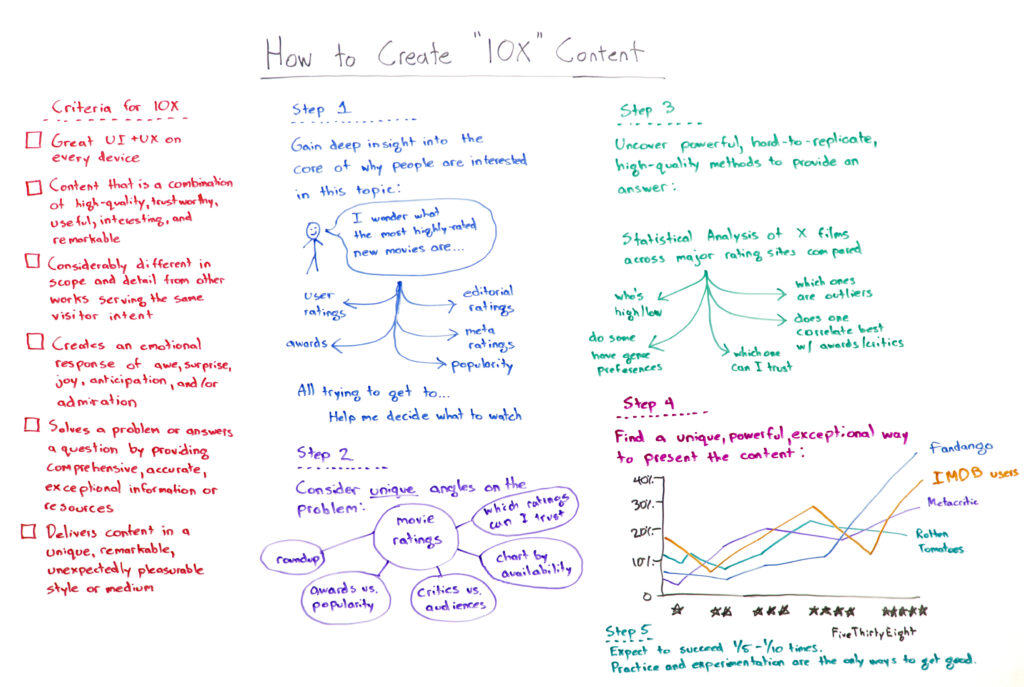
You need to look at the existing content and find gaps. There isn’t any best way to always come up with detailed content that’ll outrank existing articles.
For example, if existing articles on the topic don’t have videos embedded, adding a video will make your content more detailed. Similarly, if you create an infographic and publish it with your article, it will make your piece more detailed.
In any case, your content needs to cover all the aspects of the topic leaving nothing behind. Here is a list of the best practices you can stick with to write detailed content:
- Find related keywords and questions to include in your article
- Add media including images and videos to expand your content
- Keep content updated by adding new resources and recent citations
- Add FAQs section to address relevant questions
- Link to relevant resources on your site so that readers can find more details without leaving your website
- Use heatmaps and analytics to understand how visitors interact with the content and remove/add sections as needed.
4. Improve Content Formatting and Organization
A major aspect of helpful content is that it is well-formatted and organized. Your ideal customers should be able to find what they are looking for easily and once they find it, they should be able to read and understand it with ease.
Research shows that 37% of people leave a website due to poor navigation making it a serious hurdle in UX:

The way you present content on your blog is also crucial, not just the content – says Google. You can write the best content, but if it is poorly presented, nobody will like it.
On the contrary, you can do wonders with well-organized and presented mediocre content.
Here’s an example of how formatting improves content readership and comprehension:
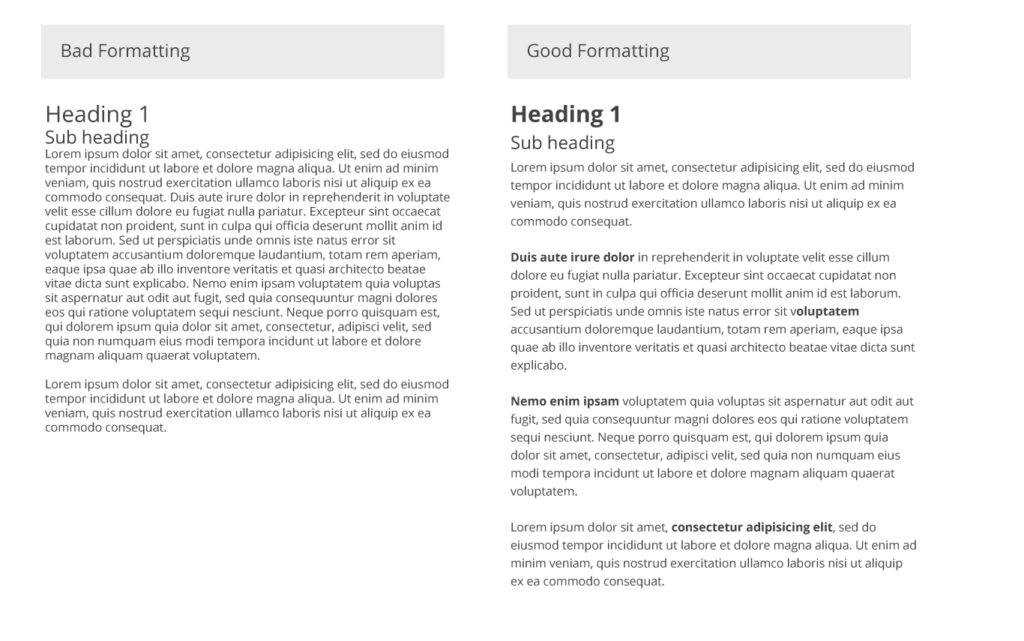
Content formatting and organization work for both readers and web crawlers. Breadcrumbs and descriptive URLs, for example, help both readers and search engines understand your site and content better.
Follow these best practices for content formatting:
- Use HTML tags for content formatting including title tag, heading tags, and alt tags
- Distribute your content into different sections. Add a proper heading tag for each section
- Use bullets and lists to improve readership and content presentation
- Add whitespace between paragraphs and headings
- Write short sentences and short paragraphs
- Use simple language and avoid technical terms and jargon
- Add a table of contents to help readers jump to the right section quickly
- Write content for skimmers as most people skim content on the internet. This means you have to add a summary of each section at the start and make your headings descriptive
- Add relevant media to simplify complex topics
- Add links to relevant sources.
Here’s a list of the techniques to organize content for better readership:
- Use descriptive URLs that explain the purpose of the page
- Add breadcrumbs at the top to improve navigation
- Use tags and categories to group similar topics
- Add a navigation menu to help readers explore relevant sections of your website
- Have a clearly defined structure for your blog.
5. Stick with Your Expertise
Google and other search engines prefer expertise over anything else. There is little room for a jack of all trades. This means you have to choose a niche and write about it exclusively to develop your authority in that niche.
There has to be an association between niche and your expertise. It is key.
Google and your readers expect to read a blog on “HR best practices” from an HR executive who has a relevant degree in human resource management and has served for more than a decade in the industry. Someone who is running an HR or business blog as a hobby isn’t an expert in the field.
This means you have to write and publish content that’s strictly relevant to your business, niche, and expertise.
The basic questions you should answer are:
- What makes you an expert in writing content on this topic?
- What qualifies your business to write a blog post on a specific topic?
The top search results for ‘project management methodologies tools and techniques’ are from project management apps and tools:

Why?
Because Google knows that these businesses are experts in project management since this is what they do.
Now, if these sites publish an article on ‘best salmon recipes’, Google won’t rank any of these sites despite their massive authority. This is because these businesses don’t have any expertise in recipes.
You get the idea, right?
Defining a niche that’s consistent with your expertise and then sticking with it is your best bet to consistently generate helpful content.
The big question: How do you develop expertise if you are new?
You need to leverage your education, experience, and authority. Expertise is developed in time, you can’t have it overnight. The rule is to showcase it in your content.
Here’s how to do it:
- Create a product in your niche or offer services in your primary field of expertise
- Create in-depth content in a specific niche consistently
- Go above and beyond when creating content
- Get endorsements and backlinks from popular, authoritative, and relevant experts
- Join relevant associations and forums
- Get certifications relevant to your niche.
You can’t become an expert in your field overnight. Give it time. What’s important is that you stick with your niche and continue publishing quality, helpful content consistently until your audience and search engines recognize you as the best resource in your niche.
It’s a tough but rewarding journey.
Final Words
Helpful, people-first content is the future. The sooner you change your content marketing strategy, the better.
You can use YouTube as an example of what type of content to create and how to create it to beat your competition.
Travel vloggers on YouTube don’t create content sitting in their homes. They visit the place and share their story with the viewers which includes both positives and negatives. Imagine if a travel vlogger told a story about a place that he has never visited, would you or anyone else would bother seeing such a video?
Unfortunately, most content you see on Google is created in the same way.
You can easily stand out if you start creating original, experience-based, and credible content.
Featured Image: Pexels



